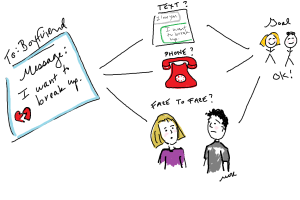I have a little dog, a mini-schnoodle we bought one year ago. My son and I lovingly refer to Daisy as “13 pounds of watch dog” although we should say “13 pounds of love,” because her main feature is her big heart. She is affectionate and sweet, always delighted when people come over. I come home and she pees with excitement and happiness. We love our little girl.
We have been in the process of training Daisy since her happy arrival in our home. This past spring we decided to bell train her. We hung a bell at her snout level, and every time we took her out we would ring the bell. The idea was to create a shared communication channel and message for “going outside.”
Daisy was right on it! Within weeks that little smartie would ring the bell when she wanted to go out. “Ding!” she’d ring, and out she would go. It was wildly successful. We thought she was the smartest dog in the world.
This lasted a good week until house construction (near her bell) began. Long story, short: Daisy uses the bell no longer.
It’s not that we don’t share a communication channel. My sister was visiting this morning, and as we chatted Daisy came up to me and said, “Woof!”
“Do you have to go outside?” I asked.
“Woof!” she said, and looked towards the back door.
I happily let her out, and returned to my table. My sister was impressed, but asked about the lack of bell-use (I had previously bragged it up).
I explained why Daisy quit using the bell, and how now Daisy will come up and tell me she has to go potty. I told her how it works perfectly if I’m present, engaged and available. But how unfortunately if I’m crabby and distracted, Daisy will bark her request and instead of being responsive, I will yell “SHUT UP!” paying little attention to her needs or her message.
The whole conversation got me thinking about communication in general. In the ideal world we should always choose the best channel for the message, one which will allow for the clearest communication of the message.
Every communication situation warrants a serious consideration of which channel best serves the need. We have many options, from nonverbal facial expressions to verbal words. Depending on the message we are trying to send, there are better “fits.” Sometimes a text will do, sometimes a phone call… and then there are situations that really do require face-to-face interaction.
We have many channels available to us, but we often choose one unwittingly. Sometimes our shyness gets in the way and we use the channel that allows us the most anonymity. Sometimes we are in the habit of texting and don’t think about it. But if the goal is to share our message, choosing the appropriate channel is important.
And so is choosing the right time! “Bad-timing” can kill any communication. If I am crabby and distracted, it isn’t a good time for anyone to try to talk to me—even a cute little white dog who desperately needs to go out. In my hot-headed or depressed moments, I don’t care a whole lot about other peoples’ needs. I’m lost in my own world. This is true for all of us! Timing our communication right greatly improves our ability to share meaning.
I will retrain Daisy on the bell. It is worth it to me to know when she needs to go out. And as I prepare for a new semester of teaching college students involving hundreds of upcoming interactions, I want to be sure and consider the most appropriate channels for these communications. Communication interactions are unique: each only gets to happen once. I want to make sure that each happens the best it can.



